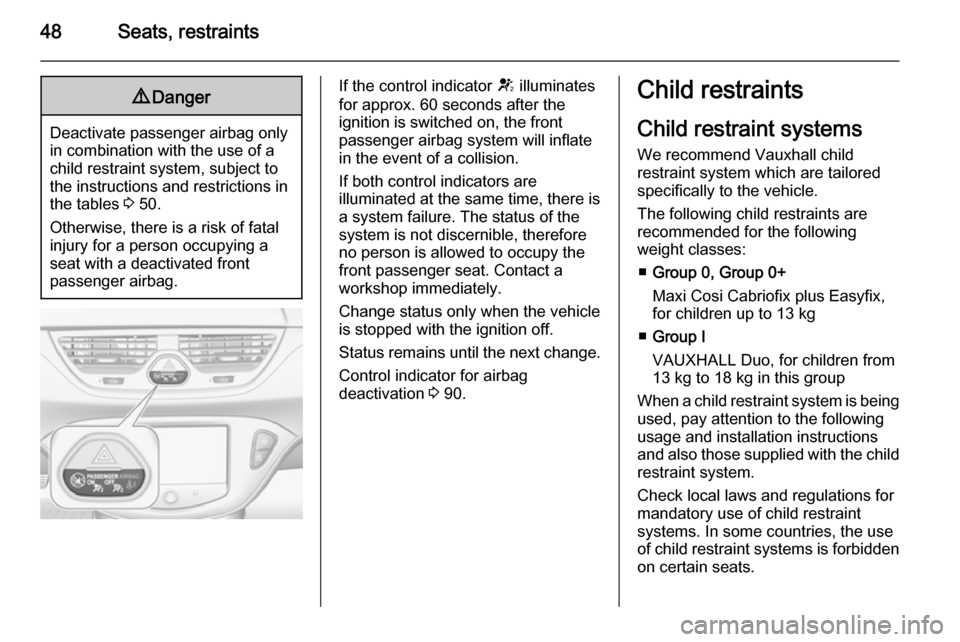weight VAUXHALL CORSA 2015.75 Owner's Manual
[x] Cancel search | Manufacturer: VAUXHALL, Model Year: 2015.75, Model line: CORSA, Model: VAUXHALL CORSA 2015.75Pages: 261, PDF Size: 7.61 MB
Page 50 of 261

48Seats, restraints9Danger
Deactivate passenger airbag only
in combination with the use of a
child restraint system, subject to
the instructions and restrictions in
the tables 3 50.
Otherwise, there is a risk of fatal
injury for a person occupying a
seat with a deactivated front
passenger airbag.
If the control indicator V illuminates
for approx. 60 seconds after the
ignition is switched on, the front
passenger airbag system will inflate
in the event of a collision.
If both control indicators are
illuminated at the same time, there is
a system failure. The status of the
system is not discernible, therefore
no person is allowed to occupy the
front passenger seat. Contact a
workshop immediately.
Change status only when the vehicle
is stopped with the ignition off.
Status remains until the next change.
Control indicator for airbag
deactivation 3 90.Child restraints
Child restraint systems
We recommend Vauxhall child
restraint system which are tailored
specifically to the vehicle.
The following child restraints are
recommended for the following
weight classes:
■ Group 0, Group 0+
Maxi Cosi Cabriofix plus Easyfix,
for children up to 13 kg
■ Group I
VAUXHALL Duo, for children from
13 kg to 18 kg in this group
When a child restraint system is being used, pay attention to the following
usage and installation instructions
and also those supplied with the child
restraint system.
Check local laws and regulations for
mandatory use of child restraint
systems. In some countries, the use
of child restraint systems is forbidden
on certain seats.
Page 52 of 261

50Seats, restraintsChild restraint installation locationsPermissible options for fastening a child restraint system with a three-point seat belt
Weight and age class
On front passenger seat
On rear outboard seatsOn rear centre seat
activated airbagdeactivated airbagGroup 0: up to 10 kg
or approx. 10 monthsXU 1,2U/L 3XGroup 0+: up to 13 kg
or approx. 2 yearsXU 1,2U/L 3XGroup I: 9 to 18 kg
or approx. 8 months to 4 yearsXU 1,2U/L 3,4XGroup II: 15 to 25 kg
or approx. 3 to 7 yearsU 1,2XU/L 3,4XGroup III: 22 to 36 kg
or approx. 6 to 12 yearsU 1,2XU/L 3,4XU=universal suitability in conjunction with three-point seat beltL=suitable for particular child restraint systems of the 'specific-vehicle', 'restricted' or 'semi-universal' categories. The child
restraint system must be approved for the specific vehicle type (refer to the vehicle type list of the child restraint system)X=no child restraint system permitted in this weight class1=move seat forwards as far as necessary and adjust seat backrest inclination as far as necessary to a vertical positionto ensure that the belt runs forwards from the upper anchorage point
Page 53 of 261

Seats, restraints51
2=move seat height adjustment upwards as far as necessary and adjust seat backrest inclination as far as necessary toa vertical position to ensure that the belt is tight on the buckle side3=move the respective front seat ahead of the child restraint system forwards as far as necessary4=adjust the respective backrest to the rearmost position 3 67, adjust the respective headrest as necessary or remove
if required 3 34
Permissible options for fitting an ISOFIX child restraint system
Weight classSize classFixture
On front passenger seat 5On rear outboard
seatsOn rear
centre seatactivated airbagdeactivated airbagGroup 0: up to 10 kg
or approx. 10 monthsEISO/R1XILIL 3XGroup 0+: up to 13 kg
or approx. 2 yearsEISO/R1XILIL 3XDISO/R2XILIL3XCISO/R3XILIL3XGroup I: 9 to 18 kg
or approx. 8 months to 4 yearsDISO/R2XILIL 3,4XCISO/R3XILIL 3,4XBISO/F2XIL/IUFIL, IUF 3,4XB1ISO/F2XXIL/IUFIL, IUF3,4XAISO/F3XIL/IUFIL, IUF 3,4X
Page 54 of 261

52Seats, restraints
Weight classSize classFixture
On front passenger seat5
On rear outboard
seatsOn rear
centre seatactivated airbagdeactivated airbagGroup II: 15 to 25 kg
or approx. 3 to 7 yearsIL 1,2XIL3,4XGroup III: 22 to 36 kg
or approx. 6 to 12 yearsIL 1,2XIL 3,4XIL=suitable for particular ISOFIX restraint systems of the "specific-vehicle", "restricted" or "semi-universal" categories.
(ISOFIX/Top-tether fastening points optional for the front passenger seat but not available for sport seats). The ISOFIX restraint system must be approved for the specific vehicle type (refer to the vehicle type list of the child
restraint system)IUF=suitable for ISOFIX forward-facing child restraint systems of universal category approved for use in this weight class
(ISOFIX/Top-tether fastening points optional for the front passenger seat (not available for sport seats)X=no ISOFIX child restraint system approved in this weight class1=move seat forwards as far as necessary and adjust seat backrest inclination as far as necessary to a vertical position to ensure that the belt runs forwards from the upper anchorage point2=move seat height adjustment upwards as far as necessary and adjust seat backrest inclination as far as necessary
to a vertical position to ensure that the belt is tight on the buckle side3=move the respective front seat ahead of the child restraint system forwards as far as necessary4=adjust the respective backrest to the rearmost position 3 67 , adjust the respective headrest as necessary or remove
if required 3 345=ISOFIX/Top-tether fastening points optional for the front passenger seat (not available for sport seats)
Page 55 of 261

Seats, restraints53
ISOFIX size class and seat deviceA – ISO/F3=forward-facing child restraint system for children of maximum size in the weight class 9 to 18 kgB – ISO/F2=forward-facing child restraint system for smaller children in the weight class 9 to 18 kgB1 – ISO/F2X=forward-facing child restraint system for smaller children in the weight class 9 to 18 kgC – ISO/R3=rear-facing child restraint system for children of maximum size in the weight class up to 18 kgD – ISO/R2=rear-facing child restraint system for smaller children in the weight class up to 18 kgE – ISO/R1=rear-facing child restraint system for young children in the weight class up to 13 kg
Page 75 of 261

Storage73Loading information
■ Heavy objects in the loadcompartment should be placedagainst the seat backrests. Ensure
that the backrests are securely
engaged. If objects can be stacked, heavier objects should be placed at
the bottom.
■ Secure objects with lashing straps attached to the lashing eyes 3 71.
■ Use the hook at the right sidewall of
the load compartment for hanging
up carrier bags. Maximum load: 5 kg.
■ Secure loose objects in the load compartment to prevent them from
sliding.
■ When transporting objects in the load compartment, the backrests ofthe rear seats must not be angled
forward.
■ Do not allow the load to protrude above the upper edge of the
backrests.
■ Do not place any objects on the load compartment cover or theinstrument panel, and do not cover
the sensor on top of the instrument
panel.
■ The load must not obstruct the operation of the pedals, parking
brake and gear selector lever, or
hinder the freedom of movement of the driver. Do not place any
unsecured objects in the interior.
■ Do not drive with an open load compartment.9 Warning
Always make sure that the load in
the vehicle is securely stowed.
Otherwise objects can be thrown
around inside the vehicle and
cause personal injury or damage
to the load or car.
■ The payload is the difference between the permitted gross
vehicle weight (see identification
plate 3 235) and the EC kerb
weight.
To calculate the payload, enter the
data for your vehicle in the Weights
table at the front of this manual.
The EC kerb weight includes
weights for the driver (68 kg),
luggage (7 kg) and all fluids (tank
90 % full).
Optional equipment and
accessories increase the kerb
weight.
■ Driving with a roof load increases the sensitivity of the vehicle to
cross-winds and has a detrimental
effect on vehicle handling due to
Page 76 of 261

74Storage
the vehicle's higher centre of
gravity. Distribute the load evenly
and secure it properly with retaining
straps. Adjust the tyre pressure and
vehicle speed according to the load conditions. Check and retighten the
straps frequently.
Do not drive faster than 75 mph.
The permissible roof load is 75 kg. The roof load is the combined
weight of the roof rack and the load.
Page 179 of 261

Driving and operating177Fuel consumption - CO2-
Emissions
The fuel consumption (combined) of
the model Vauxhall Corsa is within a
range of 38 to 91 mpg.
The CO 2 emission (combined) is
within a range of 174 to 82 g/km.
For the values specific for your
vehicle, refer to the EEC Certificate of Conformity provided with your vehicle
or other national registration
documents.
General information
The official fuel consumption and
specific CO 2 emission figures quoted
relate to the EU base model with
standard equipment.
Fuel consumption data and CO 2
emission data are determined
according to regulation R (EC)
No. 715/2007 (in the latest applicable version), taking into consideration the
vehicle weight in running order, as specified by the regulation.The figures are provided only for the
purpose of comparison between
different vehicle variants and must
not be taken as a guarantee for the
actual fuel consumption of a
particular vehicle. Additional
equipment may result in slightly
higher results than the stated
consumption and CO 2 figures.
Furthermore, fuel consumption is dependent on personal driving style
as well as road and traffic conditions.Trailer hitch
General information Only use towing equipment that has
been approved for your vehicle.
Entrust retrofitting of towing
equipment to a workshop. It may be
necessary to make changes that
affect the cooling system, heat
shields or other equipment.
Fitting of towing equipment could
cover the opening of the towing eye.
If this is the case use the coupling ball
bar for towing. Always keep the
coupling ball bar in the vehicle.
Driving characteristics and
towing tips Before attaching a trailer, lubricate
the coupling ball. However, do not do
so if a stabiliser, which acts on the coupling ball, is being used to reduce
snaking movements.
For trailers with low driving stability
and caravan trailers with a permitted
gross vehicle weight of more than
Page 180 of 261

178Driving and operating
1000 kg a speed of 50 mph must not
be exceeded; the use of a stabiliser is recommended.
If the trailer starts snaking, drive more
slowly, do not attempt to correct the
steering and brake sharply if
necessary.
When driving downhill, drive in the
same gear as if driving uphill and
drive at a similar speed.
Adjust tyre pressure to the value
specified for full load 3 249.
Trailer towing Trailer loads The permissible trailer loads are
vehicle and engine-dependent
maximum values which must not be
exceeded. The actual trailer load is
the difference between the actual
gross weight of the trailer and the
actual coupling socket load with the
trailer coupled.
The permissible trailer loads are
specified in the vehicle documents. In
general, they are valid for gradients
up to max. 12 %The permitted trailer loads apply up to the specified incline and up to an
altitude of 1000 metres above sea
level. Since engine power decreases as altitude increases due to the airbecoming thinner, therefore reducing
climbing ability, the permissible gross train weight also decreases by 10 %
for every 1000 metres of additional
altitude. The gross train weight does
not have to be reduced when driving
on roads with slight inclines (less than
8 %, e.g. motorways).
The permissible gross train weight
must not be exceeded. This weight is
specified on the identification plate
3 235.
Vertical coupling load
The vertical coupling load is the load
exerted by the trailer on the coupling
ball. It can be varied by changing the
weight distribution when loading the
trailer.Petrol and diesel engines
The maximum permissible vertical
coupling load (55 kg) is specified on
the towing equipment identification
plate and in the vehicle documents.Always aim for the maximum load,
especially in the case of heavy
trailers. The vertical coupling load
should never fall below 25 kg.Engine B14XEL LPG
The maximum permissible vertical
coupling load (45 kg) is specified on
the towing equipment identification
plate and in the vehicle documents.
Always aim for the maximum load,
especially in the case of heavy
trailers. The vertical coupling load
should never fall below 25 kg.
Rear axle load
Petrol and diesel engines
When the trailer is coupled and the
towing vehicle fully loaded, the
permissible rear axle load (see
identification plate or vehicle
documents) for passenger vehicles
may be exceeded by 70 kg for the 5-
door vehicle and 60 kg for the 3-door
vehicle, the gross vehicle weight
rating by 55 kg.
Page 181 of 261

Driving and operating179
Engine B14XEL LPG
When the trailer is coupled and the
towing vehicle fully loaded, the
permissible rear axle load (see
identification plate or vehicle
documents) for passenger vehicles
may be exceeded by 70 kg for the 5-
door vehicle and 70 kg for the 3-door
vehicle, the gross vehicle weight
rating by 45 kg.Delivery van
When the trailer is coupled and the
towing vehicle fully loaded, the
permissible rear axle load (see
identification plate or vehicle
documents) for passenger vehicles
may be exceeded by 60 kg, the gross
vehicle weight rating by 55 kg.General
If the permitted rear axle load is
exceeded a maximum speed of
60 mph applies. If lower national
maximum speeds are specified for
trailer operation, they must be
complied with.Towing equipmentCaution
When operating without a trailer,
remove the coupling ball bar.
Stowage of coupling ball bar
The coupling ball bar is stowed in a
bag in the spare wheel well and
secured to the lashing eyes in the
load compartment.
When inserting, fit protective cap over
rotary knob with key.
Fitting the coupling ball bar
Disengage and fold down the socket. Remove the sealing plug from the
opening for the coupling ball bar and
stow it.